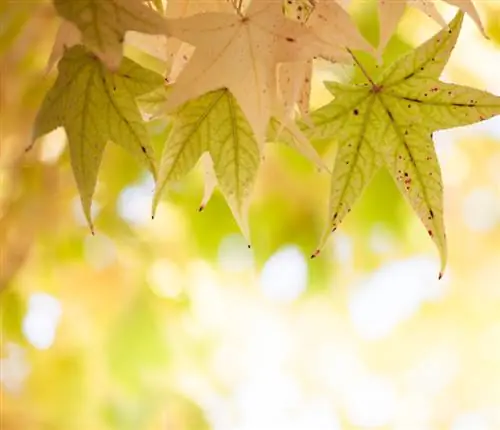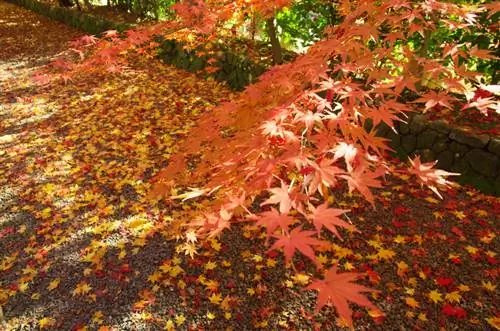- Author admin [email protected].
- Public 2023-12-16 16:46.
- Last modified 2025-01-23 11:22.
The Japanese maple is a popular garden plant and is often cultivated in pots on the balcony or terrace. We explain how waterlogging damages plants and what you can do if it has already formed.

How do you protect Japanese maple from waterlogging?
Waterlogging is harmful to the Japanese maple because it causes root rot. To save the plant, remove rotten roots, dry the root ball, create drainage and plant in new soil with clay granules. Water regularly and avoid waterlogging.
Does waterlogging damage the Japanese maple?
Waterlogging isvery harmful for the Japanese maple. If the plant is left too wet for some time and the water has no way to drain away, the roots can begin to rot. This affects the entire plant. Maple plants in pots in particular are very susceptible to waterlogging because they are often in too much water.
What to do if Japanese maple is affected by waterlogging?
Afast and careful action is very important, this is the only way the plant can be saved:
- remove the root ball completely from soil
- cut off rotten roots generously and thoroughly
- let the root ball dry completely
- Create a drainage system over the drain hole of the plant pot, for example made of pottery shards (€19.00 on Amazon), which are permeable to moisture
- insert a fleece as an intermediate layer
- then plant the maple back in soil (be sure to use new soil, preferably mixed with clay granules)
Some fertilizer is recommended every four weeks from April to August.
Does Japanese maple need a lot of water?
Japanese maple in a pot needs to be watered sufficiently because it has aquite high water requirement. The following points should be noted:
- water regularly, twice a day in summer
- only water when the soil is superficially dry
- drain the excess water on the base of the plant pot after about half an hour
As a container plant, the Japanese maple requires more care than specimens planted in the garden, which are happy with rainwater and normal garden irrigation as needed.
What does a waterlogged Japanese maple tree look like?
If a Japanese maple is affected by waterlogging, this can manifest itself inbrown leaf edges. However, these can also mean the exact opposite - drought damage can also be noticeable through brown leaves.
In addition,rolled leaves can be a result of unwanted growth on the roots Waterlogging has formed. Since the rotten roots can no longer absorb liquid or nutrients and pass them to the leaves, they ultimately look as if they have dried up.
Tip
It's better not to use plastic buckets
If you want to cultivate Japanese maple in containers, it is not only important to use a sufficiently high and wide planter. The right material is also important: pots made of clay are ideal, as excess water easily finds its way out. Plastic containers are unsuitable as they can even promote waterlogging.






